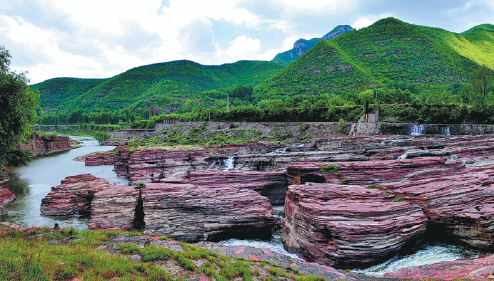Greening campaigns transforming Shanxi's natural environment
Updated: 2023-12-08

The county of Licheng now offers scenery of green mountains and clear waters after decades of efforts in greening and curbing soil erosion. [Photo provided to China Daily]
Decades of government afforestation programs combat widespread soil erosion and breathe new life into province's previously barren land
When the Yellow River enters Shanxi in the county of Pianguan, residents of this North China province begin their relay to protect the ecological environment of this Chinese river, as they deem this mission crucial to their own well-being as well as people in the lower reaches.
The 5,464-kilometer Yellow River, originating in the Qinghai-Tibet Plateau and emptying into Bohai Bay, is the second-longest river in China. It is regarded as the mother river of the nation because it has nurtured Chinese civilization for millennia.
The Shanxi section of the Yellow River is 965 km in length. More than 73.1 percent of the land in Shanxi, covering 114,600 square kilometers across 11 cities, belongs to the river's drainage basin. The river's drainage area in Shanxi is also home to 73.4 percent of the province's population and makes up the majority of provincial GDP.
As Shanxi is located on the Loess Plateau, soil erosion has been a challenge to the ecological environment of the Yellow River for thousands of years.
In the early 1950s, the area of soil erosion in Shanxi was 108,000 sq km, of which 67,600 sq km was in the Yellow River drainage basin. Soil erosion-induced annual sediment in the Yellow River was 366 million metric tons during that period.
Pianguan, the first county in Shanxi that embraces the Yellow River, had been one of the regions hardest-hit by soil erosion. During its worst period in the 1970s, about 81 percent of its land suffered from soil erosion.
The county began a massive campaign to curb soil erosion in the 1970s. The move is a combination of land greening and engineering measures for gully head protection and farmland modification.
Tangible progress has been made over the past decades. One remarkable feature is the sustained growth of vegetation coverage. Local statistics show that the county's forest coverage increased from less than 3.5 percent in 1977 to 48.6 percent in 2022.
Local residents have now reaped dividends from the improved environment.
Yaowangping is one of the villages in Pianguan that began a soil erosion control program in the 1970s by modifying hillside farms into terraced plantations, building gully dams and planting trees and grass on bare hills.
Su Jun, a local farmer, now operates a 21-hectare vineyard along one of the gullies.
"Growing grapes can generate much better revenue than other crops," Su said. "But this was impossible in the past as a heavy rain would wash away everything you planted."
He explained the increasing coverage of vegetation on neighboring hills and the dams built along the gullies have effectively prevented soil erosion from happening. "All these efforts have led to the substantial improvement of farmlands and crop yields have been stabilized."
Pianguan is the place where the Yellow River and Great Wall meet. The two are now among the top three landmark tourist attractions in Shanxi.
"As the river is becoming cleaner and the mountains near the Great Wall are greener, we are welcoming a growing number of tourists and securing more revenue," said an official of the county.
The county of Xiangning has adopted a similar approach as Pianguan in curbing soil erosion.
Zhang Penggang, an official at the county's water resources bureau, cited the example of Tuojian village to illustrate Xiangning's progress in soil erosion control.
Tuojian is a gully-side village some 2.5 km to the Yellow River. "In the past, a flood can wash everything – soil, crops or even houses – into the Yellow River," Zhang said.
"Over the past decades, we have built four large and medium-sized dams along the valley, basically freeing locals from such disasters," Zhang said. He added that about 1,000 hectares of terraced farmlands have been developed along the gully, ensuring more stable and higher yields from farming.
At present, nearly 90 percent of land in the gully's drainage area has been covered by vegetation, according to the official.
"We have made similar efforts for other gullies in Xiangning, which helped the county win the honor of 'a national role model in curbing soil erosion in small drainage areas' in 2022."
Experiencing the same transformation is the county of Puxian. It has seen its forest coverage increase from 17 percent in 1984 to 59 percent in 2022. This high rate saw the county gain recognition from the Ministry of Ecology and Environment as a case of best practice for "developing lucid waters and green mountains into valuable assets".
To further curb soil erosion and protect farmlands, the county government invested 6.3 million yuan ($880,000) to launch a new gully head protection project in May. It was completed at the end of last month.
In the province as a whole, Shanxi has invested more than 4 billion yuan in controlling soil erosion – including building gully dams and developing terraced farms – over the past five years, according to Cheng Jie'an, deputy chief of the Shanxi Department of Water Resources. He added that this move has protected more than 15,000 sq km of land from soil erosion.
Kang Meixiang contributed to this story.



